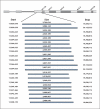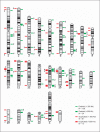Refining the 22q11.2 deletion breakpoints in DiGeorge syndrome by aCGH
- PMID: 19420922
- PMCID: PMC2919456
- DOI: 10.1159/000207515
Refining the 22q11.2 deletion breakpoints in DiGeorge syndrome by aCGH
Abstract
Hemizygous deletions of the chromosome 22q11.2 region result in the 22q11.2 deletion syndrome also referred to as DiGeorge, Velocardiofacial or Shprintzen syndromes. The phenotype is variable but commonly includes conotruncal cardiac defects, palatal abnormalities, learning and behavioral problems, immune deficiency, and facial anomalies. Four distinct highly homologous blocks of low copy number repeat sequences (LCRs) flank the deletion region. Mispairing of LCRs during meiosis with unequal meiotic exchange is assumed to cause the recurrent and consistent deletions. The proximal LCR is reportedly located at 22q11.2 from 17.037 to 17.083 Mb while the distal LCR is located from 19.835 to 19.880 Mb. Although the chromosome breakpoints are thought to localize to the LCRs, the positions of the breakpoints have been investigated in only a few individuals. Therefore, we used high resolution oligonucleotide-based 244K microarray comparative genomic hybridization (aCGH) to resolve the breakpoints in a cohort of 20 subjects with known 22q11.2 deletions. We also investigated copy number variation (CNV) in the rest of the genome. The 22q11.2 breaks occurred on either side of the LCR in our subjects, although more commonly on the distal side of the reported proximal LCR. The proximal breakpoints in our subjects spanned the region from 17.036 to 17.398 Mb. This region includes the genes DGCR6 (DiGeorge syndrome critical region protein 6) and PRODH (proline dehydrogenase 1), along with three open reading frames that may encode proteins of unknown function. The distal breakpoints spanned the region from 19.788 to 20.122 Mb. This region includes the genes GGT2 (gamma-glutamyltransferase-like protein 2), HIC2 (hypermethylated in cancer 2), and multiple transcripts of unknown function. The genes in these two breakpoint regions are variably hemizygous depending on the location of the breakpoints. Our 20 subjects had 254 CNVs throughout the genome, 94 duplications and 160 deletions, ranging in size from 1 kb to 2.4 Mb. The presence or absence of genes at the breakpoints depending on the size of the deletion plus variation in the rest of the genome due to CNVs likely contribute to the variable phenotype associated with the 22q11.2 deletion or DiGeorge syndrome.
Copyright 2009 S. Karger AG, Basel.
Figures



Similar articles
-
22q11.2 distal deletion: a recurrent genomic disorder distinct from DiGeorge syndrome and velocardiofacial syndrome.Am J Hum Genet. 2008 Jan;82(1):214-21. doi: 10.1016/j.ajhg.2007.09.014. Am J Hum Genet. 2008. PMID: 18179902 Free PMC article.
-
Low copy repeats mediate distal chromosome 22q11.2 deletions: sequence analysis predicts breakpoint mechanisms.Genome Res. 2007 Apr;17(4):482-91. doi: 10.1101/gr.5986507. Epub 2007 Mar 9. Genome Res. 2007. PMID: 17351135 Free PMC article.
-
Der(22) syndrome and velo-cardio-facial syndrome/DiGeorge syndrome share a 1.5-Mb region of overlap on chromosome 22q11.Am J Hum Genet. 1999 Mar;64(3):747-58. doi: 10.1086/302284. Am J Hum Genet. 1999. PMID: 10053009 Free PMC article.
-
22q11.21 Deletion Syndromes: A Review of Proximal, Central, and Distal Deletions and Their Associated Features.Cytogenet Genome Res. 2015;146(2):89-99. doi: 10.1159/000438708. Epub 2015 Aug 8. Cytogenet Genome Res. 2015. PMID: 26278718 Review.
-
Molecular mechanisms and diagnosis of chromosome 22q11.2 rearrangements.Dev Disabil Res Rev. 2008;14(1):11-8. doi: 10.1002/ddrr.3. Dev Disabil Res Rev. 2008. PMID: 18636632 Free PMC article. Review.
Cited by
-
Consequences of 22q11.2 Microdeletion on the Genome, Individual and Population Levels.Genes (Basel). 2020 Aug 22;11(9):977. doi: 10.3390/genes11090977. Genes (Basel). 2020. PMID: 32842603 Free PMC article. Review.
-
Microdeletion and microduplication analysis of chinese conotruncal defects patients with targeted array comparative genomic hybridization.PLoS One. 2013 Oct 2;8(10):e76314. doi: 10.1371/journal.pone.0076314. eCollection 2013. PLoS One. 2013. PMID: 24098474 Free PMC article.
-
An exploratory study of predisposing genetic factors for DiGeorge/velocardiofacial syndrome.Sci Rep. 2017 Jan 6;7:40031. doi: 10.1038/srep40031. Sci Rep. 2017. PMID: 28059126 Free PMC article.
-
Trans-acting epigenetic effects of chromosomal aneuploidies: lessons from Down syndrome and mouse models.Epigenomics. 2017 Feb;9(2):189-207. doi: 10.2217/epi-2016-0138. Epub 2016 Dec 2. Epigenomics. 2017. PMID: 27911079 Free PMC article. Review.
-
Resolving the 22q11.2 deletion using CTLR-Seq reveals chromosomal rearrangement mechanisms and individual variance in breakpoints.Proc Natl Acad Sci U S A. 2024 Jul 30;121(31):e2322834121. doi: 10.1073/pnas.2322834121. Epub 2024 Jul 23. Proc Natl Acad Sci U S A. 2024. PMID: 39042694 Free PMC article.
References
Publication types
MeSH terms
Substances
Grants and funding
LinkOut - more resources
Full Text Sources
Miscellaneous

